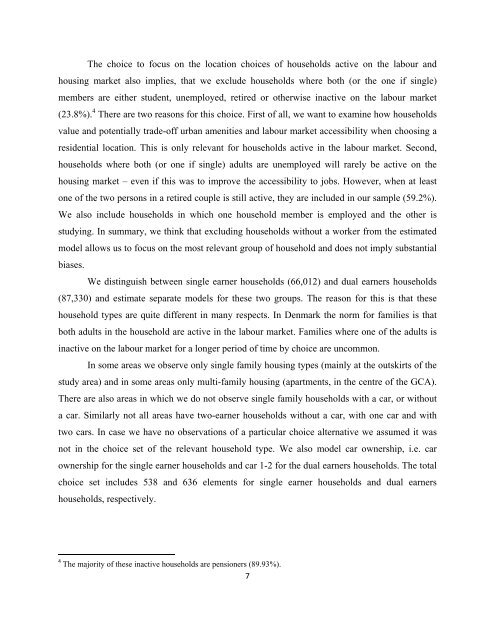Car Ownership? Evidence from the Copenhagen Metropolitan Area
n?u=RePEc:tin:wpaper:20150139&r=dem
n?u=RePEc:tin:wpaper:20150139&r=dem
You also want an ePaper? Increase the reach of your titles
YUMPU automatically turns print PDFs into web optimized ePapers that Google loves.
The choice to focus on <strong>the</strong> location choices of households active on <strong>the</strong> labour and<br />
housing market also implies, that we exclude households where both (or <strong>the</strong> one if single)<br />
members are ei<strong>the</strong>r student, unemployed, retired or o<strong>the</strong>rwise inactive on <strong>the</strong> labour market<br />
(23.8%). 4 There are two reasons for this choice. First of all, we want to examine how households<br />
value and potentially trade-off urban amenities and labour market accessibility when choosing a<br />
residential location. This is only relevant for households active in <strong>the</strong> labour market. Second,<br />
households where both (or one if single) adults are unemployed will rarely be active on <strong>the</strong><br />
housing market – even if this was to improve <strong>the</strong> accessibility to jobs. However, when at least<br />
one of <strong>the</strong> two persons in a retired couple is still active, <strong>the</strong>y are included in our sample (59.2%).<br />
We also include households in which one household member is employed and <strong>the</strong> o<strong>the</strong>r is<br />
studying. In summary, we think that excluding households without a worker <strong>from</strong> <strong>the</strong> estimated<br />
model allows us to focus on <strong>the</strong> most relevant group of household and does not imply substantial<br />
biases.<br />
We distinguish between single earner households (66,012) and dual earners households<br />
(87,330) and estimate separate models for <strong>the</strong>se two groups. The reason for this is that <strong>the</strong>se<br />
household types are quite different in many respects. In Denmark <strong>the</strong> norm for families is that<br />
both adults in <strong>the</strong> household are active in <strong>the</strong> labour market. Families where one of <strong>the</strong> adults is<br />
inactive on <strong>the</strong> labour market for a longer period of time by choice are uncommon.<br />
In some areas we observe only single family housing types (mainly at <strong>the</strong> outskirts of <strong>the</strong><br />
study area) and in some areas only multi-family housing (apartments, in <strong>the</strong> centre of <strong>the</strong> GCA).<br />
There are also areas in which we do not observe single family households with a car, or without<br />
a car. Similarly not all areas have two-earner households without a car, with one car and with<br />
two cars. In case we have no observations of a particular choice alternative we assumed it was<br />
not in <strong>the</strong> choice set of <strong>the</strong> relevant household type. We also model car ownership, i.e. car<br />
ownership for <strong>the</strong> single earner households and car 1-2 for <strong>the</strong> dual earners households. The total<br />
choice set includes 538 and 636 elements for single earner households and dual earners<br />
households, respectively.<br />
4 The majority of <strong>the</strong>se inactive households are pensioners (89.93%).<br />
7


